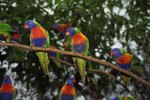
Monkeys and orangutans are primates, so they have quite a bit in common. All primates possess opposable thumbs, fingernails instead of claws and hair instead of fur. There are also a few differences between monkeys and orangutans, such as lifespan and size.
Getting Around
Orangutans and monkeys are arboreal, meaning they spend a lot of time in trees moving from place to place. They don't walk upright, either. Instead, they use all four limbs when they decide to venture down from the trees. Once they're on the ground, they don't walk on all fours quite the same. Monkeys use the whole sole of their foot when they walk, with their palms up. Orangutans close their fists or extend their palms flat. Their toes and fingers can grasp objects and are padded with prints.
Dining Choices
Monkeys and orangutans are omnivores, so they eat many of the same things, particularly vegetation and fruit. They'll both dine on other options, such as small animals, insects and bird eggs. Of course, there are more than 200 species of monkeys, and not all of them eat meat, so they don't always choose the same thing from the menu.
Thinking for Themselves
Monkeys and orangutans are pretty smart creatures, and both have demonstrated their intelligence and problem-solving abilities in captivity. They can learn from experience, though orangutans can also learn through others' experience, and not just from their own. Monkeys and orangutans will use tools and can recognize themselves in mirrors. Both have depth perception and depend on their good vision more than their sense of smell.
Some Differences
The biggest difference between monkeys and orangutans is the presence of a tail. If there's even the smallest nub on the back of the guy, he's a monkey. There are a few other differences, as well. Monkeys are highly social creatures and spend time in troops, whereas orangutans tend to be solitary; their population density is very light, only averaging about six orangutans per square mile. Ultimately, the degree of similarity between monkeys and orangutans depends on the specific breed of monkey.
References
Photo Credits
-
John Foxx/Stockbyte/Getty Images




